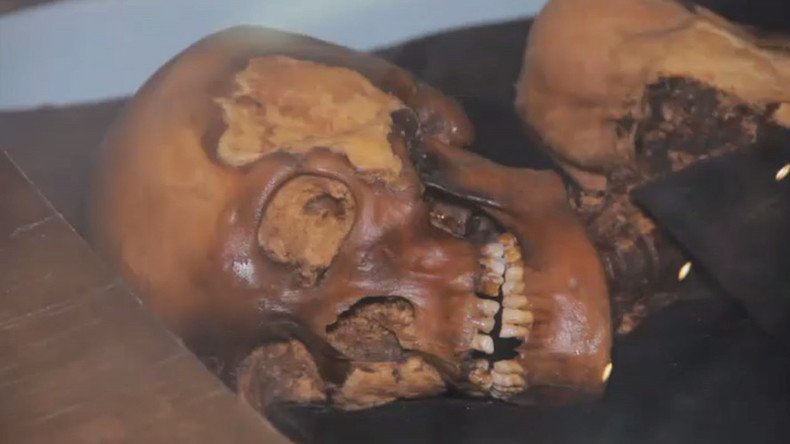An ice mummy princess has gone on public display for the first time at a museum near her original burial site, despite pleas for the body to be returned to the ground over concerns it carries an ancient ‘curse’.
The 2,500 year-old skeleton dubbed the ‘Siberian Ice Maiden’ was found extraordinarily well-preserved in permafrost on the Ukok Plateau in the Altay Mountains in 1993.
A team led by Russian archaeologists found the ‘Princess of Ukok’ buried alongside a group of six horses, while her leather-like skin displayed clear ancient tattoos.
Reconstructions of the tattoos were later revealed by the Siberian Times, showing that the 25-year-old woman’s arms were covered in remarkably modern animal tattoos.
Artifacts discovered buried alongside the woman included a small stash of cannabis.
While the find has been hailed as one of the greatest discoveries of the 20th century, there have been fears that archaeologists unearthed more than they bargained for when they raised the princess from the soil.
Local council elders in the Altay Region, which borders Kazakhstan, Mongolia and China, have previously expressed their dread at the princess’ release from the tomb, believing her excavation unleashed a curse causing natural disasters.
READ MORE: Siberian elders vote to bury 2,500yo mummy to stop quakes, floods
Earlier this year, a court came down on the side of science in a case brought by Altay locals demanding a reburial.
“The dead cannot be disturbed, and especially they cannot be held on public display and carried out around the world. After she was dug out, we immediately saw earthquakes, floods, and hail which were not known previously,” a Teles group leader said at the time, report the Siberian Times.
Since being cut from her icy tomb, experts involved in the preservation of Vladimir Lenin have been studying the princess’ remains at a research centre in the Russian city of Novosibirsk. DNA testing determined that she was quite possibly of Scythian nomad ancestry.
Now for the first time the ancient mummy will go on public show at a museum in the Altay Republic, some 500km for her original resting place.
The mummy is only due to be on display at certain times of the day at the National Museum of AV Anokhin, which houses natural history, art and archaeological collections.
“The mummy of a woman was found on the Ukok plateau on the border with Mongolia and China in 1993,” said Rimma Erkinova, of the Anokhin Museum.
“This discovery was one of the most sensational archaeological discoveries of the 20th century. There are only very few mummies in the world that are as well preserved as Princess of Ukok.
“Regarding the tattoo, they always say that it is made in the so-called animal style. Fighting animals. The Scythians are warriors. Their life is a constant struggle. They struggle for life, for good.”
In September 1991, frozen human remains of a man, nicknamed Otzi the Iceman, were found in the Italian Alps.
The 5,300 year old mummy dated back to the Chalcolithic period and was found to have 61 mysterious line tattoos, which scientists say were created by piercing the skin and rubbing the wounds with charcoal.


